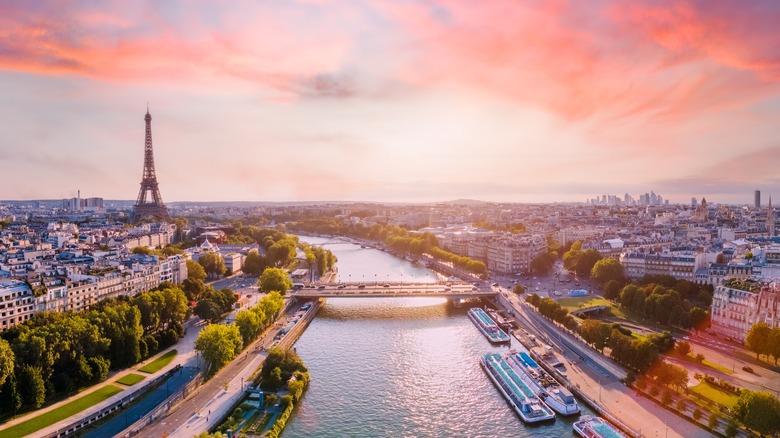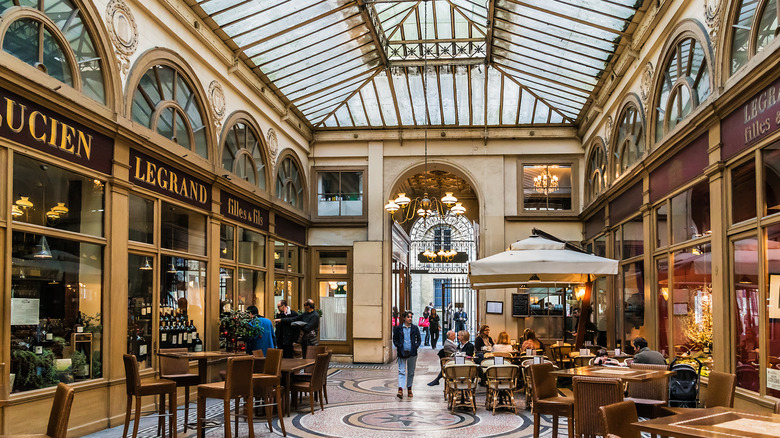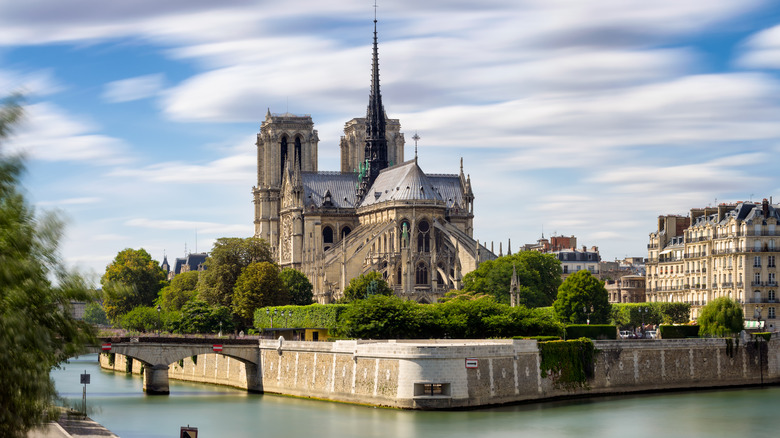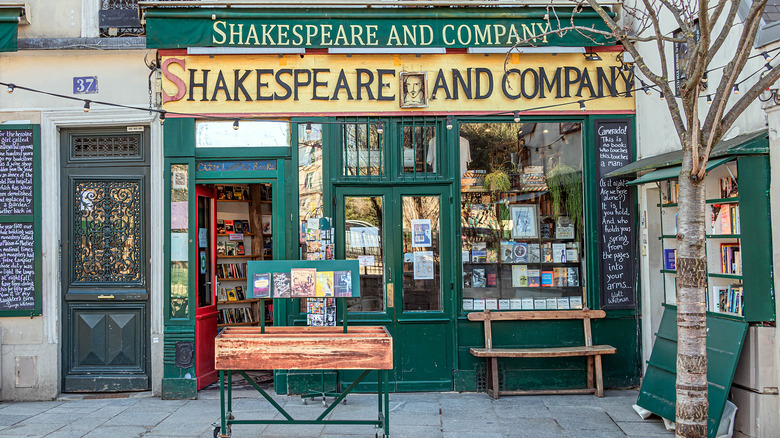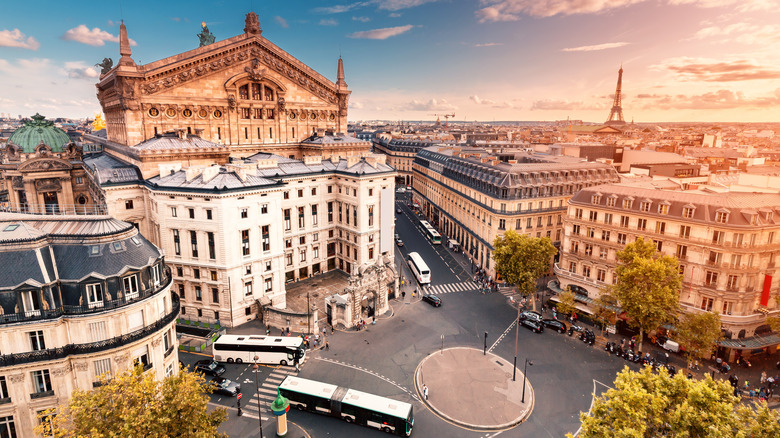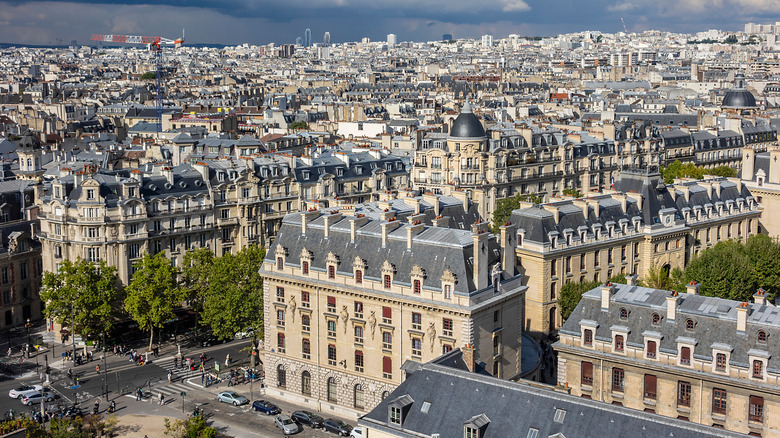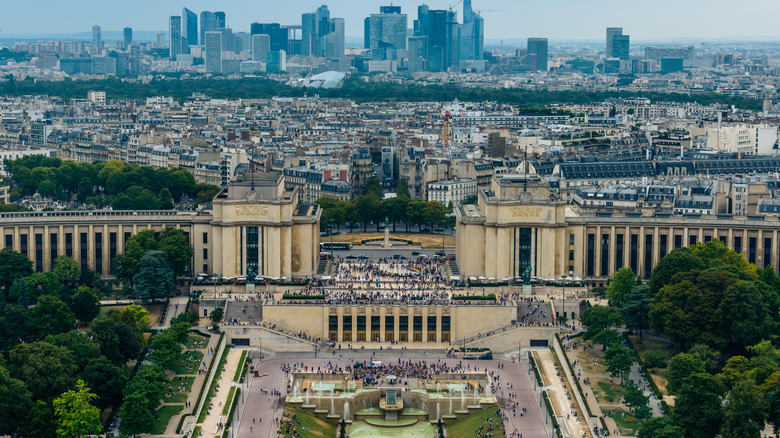The Best Neighborhoods For American Expats In Paris
If a trip to Paris sounds like a great idea, why not consider making it your new residence? Whether permanent or temporary, the City of Light offers several appealing neighborhoods for American expatriates to consider. Originally established with twelve arrondissements (administrative districts) in the late 18th century, the snail-shaped region is numbered according to the last two digits of each district's postal code. Eight more districts were added under Napoleon III's reign in 1860, and the expansion brought the total up to the 20 arrondissements that exist today amidst the Left (south) and Right (north) Banks of the Seine River (via The Local).
Within the Left Bank's six arrondissements, you might settle into one that's immersed in traditional Parisian life, including artist havens, historical attractions, cafés, restaurants, and a bustling nightlife, not to mention the dazzling Eiffel Tower. North of the river, the Right Bank consists of 14 districts filled with shops, gardens, and museums such as the Louvre and Montmartre. You'll find more low-key, affordable areas on the outer rim of the spiral that host some of the best expat schools in the city. From luxurious to modest, Paris offers multiple housing options. (Baron) Haussmann-style apartments often showcase the grandest of spaces on the second floor with the more quaint accommodations of a chambre de bonne (studio walk-up) on the sixth floor. Depending on what you seek, there's a place for any American in Paris. Here, we've highlighted some of our favorites.
2nd arrondissement
A charming, old-world district, the 2nd arrondissement, also called Bourse, is the smallest area within the city's municipalities. Although known for its many 19th century covered passage arcades, food, and marketplaces, including the lavish Galerie Vivienne, the business-centered borough is home to the former Paris Stock Exchange (Place de la Bourse). Additionally, the 2nd is a current hub for international and tech industry companies like Facebook and Le Bon Coin (via Paris Rental). Foodies can indulge in famous restaurants like Le Grand Colbert, and everyone can enjoy notable Parisian charms like Le Grand Rex, the largest movie theatre, Rue des Degrès, the smallest street (a stairway), and the fanciful old patisserie called Strohrer, established in 1730.
Located adjacent from the highly touristy 1st arrondissement, the 2nd is busy, yet distant and peaceful enough to get on with daily life. It is divided into Bonne-Nouvelle, Bourse-Sentier, Sentier, and Vivienne, and it's a place where you can find a good apartment for a reasonable price. Many expat professionals call the fascinating area home where numerous stacked buildings offer the opportunity for a top floor apartment with attractive views. With many accommodations already furnished, studios go for around $1,250 per month with one and two bedrooms falling between $2,250 and $3,500.
4th arrondissement
Filled with gothic architecture and charm, the 4th arrondissement, also named Hôtel-de-Ville, is for pure romantics. It is situated along the Right Bank, and it may just be the heart of the city. The serene area offers walks along the Seine with easy access to the urban islands of Île Saint-Louis and Île de la Cité, where the medieval Notre-Dame de Paris stands. With an array of cafés, shops, and galleries, the 4th provides endless opportunities for exploration within the main neighborhoods of Arsenal, Saint-Gervais, Saint-Merri, and Notre-Dame, per World in Paris. Places like the modern Centre Pompidou, Paris City Hall, and Place de Vosges, known as the oldest and loveliest of all squares in the city, are located nearby.
With beautiful, antiquated buildings and an eclectic mix of cultures like the Jewish borough of Pletzl, the 4th district is somewhat discreet. According to Expat Arrivals, the picturesque neighborhood is home to a more mature scene of people who enjoy basking in a tranquil life near the water. Because of its location within the center of Paris, rental prices will be higher, although worth the push. Studio and one-bedroom apartments average between $1,350 and $1,600 per month, with additional bedrooms raising the price as high as $5,500 (via Paris Stay).
5th arrondissement
The 5th arrondissement, located to the south along the Left Bank, is well-suited for academic expats. Filled with bookstores, gardens, museums, respectable high schools, and universities, the 5th is most notably home to the magnificent and ancient Roman temple, the Panthéon. This district is sometimes referred to as the Latin Quarter (along with the 6th arrondissement). The stimulating educational and research district also features the world-renowned Shakespeare and Company bookstore and Sorbonne University, per Snippets of Paris. You can also visit the riveting Jardin de Plantes (Garden of Plants), which is home to hundreds of animal and plant fossils. Museums and other enlightening establishments located within the neighborhood include the Arab World Institute and the Great Mosque of Paris.
Locals and visitors alike adore the 5th arrondissement for its rich Roman history and authentic Parisian lifestyle. Here, you'll find everything from cozy cafés to college bars and jazz clubs. Given the area's popularity and centralized location, apartments can be a bit steep. Equipped studios range anywhere from $850 to $1,650, and two to three bedroom apartments go for $2,200 and up (via NY Habitat).
9th arrondissement
Known for its diverse arts and theater scene, the 9th arrondissement never fails to entertain. From the grand Palais Garnier opera house to the Théâtre Mogador, the Right Bank Opéra district is tucked away from the crowds but still manages a great selection of bakeries, cafés, and gourmet restaurants for your everyday nosh. The area of Grands Boulevards is not to miss with historic music halls to muse in and exclusive museums to explore. The walkable streets will take you shopping at luxe department stores among both Galeries Lafayette and Printemps and through many covered passageways that are fun to venture through on rainy days, notes Everyday Parisian.
Amidst all the history and culture in the 9th, the area remains distinctively residential. Reminiscent of the Belle Époque era (beautiful age), the straight and wide avenues are pleasantly distinguished, especially along Haussmann Boulevard with its authentic Haussmann-style apartment row blocks. A decent, furnished studio apartment will range from $900 to $1,350, and one-bedrooms from $1,500 to $2,500. Two and three bedrooms in the 9th are typically available for $2,800 to $4,000 and higher (via Paris Attitude).
11th arrondissement
The 11th arrondissement is for the spirited and vogue. Also known as Popincourt, the lively, yet comfortable district is located to the northeast within the Right Bank between the 3rd and 20th arrondissements. Filled with significant monuments like the Bastille, the vibe varies in all directions. Similar to New York City's Greenwich Village, the Oberkampf area is a trendy hub for nightlife with numerous swanky bars, nightclubs, and chic restaurants to experience, explains Paris Perfect. The 11th district offers a strong sense of community and features various artisanal businesses and craft shops as well as protected bike lanes. Boulevard Richard Lenoir is a highlight; the lengthy promenade features a weekly art market in addition to one of the largest bi-weekly produce markets in the city, Marché Bastille. The boulevard also boasts several children's playgrounds along the way.
Undoubtedly cool, the Popincourt offers a place for American expats to blend in easily. Depending on your budget, pricier rental options may be found on the west side while more opportunity and affordability likely exists on the east end. Although the fashionable district is recognized as one of the most populous regions in Europe, per Housing Anywhere, accommodations are generally cheaper overall compared to other parts of the city. You may find reasonable student housing that ranges from $600 to $700 a month, studios for around $850, and one-bedroom apartments between $1,200 and $2,200.
16th arrondissement
Gain a different perspective by living in the vast and sophisticated 16th arrondissement. Located just west of the Seine, the 16th, or Passy, is the largest district. This area features sunrises over the Eiffel Tower along with the mesmerizing fountains of Trocadéro Gardens and the anthropological Homme Museum. Fashioned by its vibrant art and culture, Passy is home to numerous reputable schools, restaurants, shopping outlets, and spacious parks. As a resident, you might explore places like Museé Marmottan Monet, the National Marine Museum, Honoré de Balzac's house museum, and the Wine Museum. Once royal hunting grounds, the beautiful and immense Bois de Boulogne is only steps away. This public park is situated along the edge of the neighborhood and offers over 2,000 acres of green space and wooded areas to saunter through. There's also a botanical garden, lakes, an amusement park, and a zoo, per Trip Savvy.
Passy is particularly residential, yet the area is known to be elegantly relaxed with spacious roadways and more classic Haussmann-style buildings. Although the 16th may be pricey for some, many families including expats choose to call the augmented district home due to its close access to the highly esteemed International School of Paris. Studios here range between $1,300 and $1,600, while one-bedrooms average around $2,700 (via Properstar).
